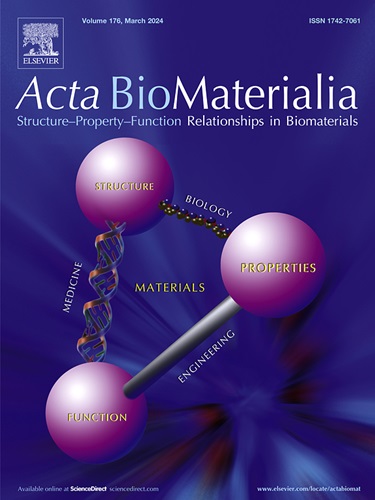Enhanced delivery of camptothecin to colorectal carcinoma using a tumor-penetrating peptide targeting p32
IF 9.4
1区 医学
Q1 ENGINEERING, BIOMEDICAL
引用次数: 0
Abstract
Camptothesome, a sphingomyelin (SM)-conjugated camptothecin (CPT) vesicular nanotherapeutic, addresses the poor solubility and lactone instability of CPT while enhancing drug loading, pharmacokinetics, and tumor distribution compared to CPT physically entrapped in conventional liposomes. Despite these improvements, the tumor uptake remains limited. To further enhance the tumor delivery efficiency and minimize the off-target distribution, we functionalize Camptothesome with the LinTT1 peptide, a CendR motif, which binds to overexpressed p32 proteins on tumor cell surface, initiating effective transcytosis for deep tumor penetration. Via systematic screening, the optimal peptide ratio on Camptothesome is identified. LinTT1/Camptothesome significantly increases cancer cell uptake without affecting normal cell internalization, resulting in enhanced anti-colorectal cancer cells activity. Additionally, decorating Camptothesome with the LinTT1 cell-penetrating peptide enables effective transcytosis via a Golgi-dependent intracellular trafficking mechanism, significantly improving the intratumoral delivery while reducing distribution to normal tissues. In a human HCT116 xenograft colorectal cancer (CRC) mouse model, LinTT1/Camptothesome demonstrates superior antitumor efficacy compared to both Camptothesome and Onivyde by upregulating cleaved caspase-3 and γH2AX. Our study substantiates the potential of leveraging a tumor-penetrating peptide to enhance the tumor delivery efficiency of Camptothesome, maximizing its therapeutic index for improved treatment of human CRC.
Statement of significance
Despite the improved tumor delivery achieved by Camptothesome, its tumor distribution and penetration remain limited. This is because the enhanced permeability and retention effect only facilitates nanotherapeutic distribution to tumor periphery through leaky vasculature. The C-end Rule (CendR) motif-neuropilin receptor system enhances tumor-homing peptides by binding to cellular surface receptors, triggering transcytosis. Herein, LinTT1, the most potent CendR peptide that binds to the overexpressed p32 receptor on cancer cells, was effectively engineered onto Camptothesome using thiol-maleimide lipid chemistry. The LinTT1/Camptothesome significantly enhanced tumor uptake and penetration while minimizing accumulation in normal tissues, demonstrating remarkable anticancer efficacy in a human xenograft colorectal cancer model. Our findings highlight the critical role of tumor-homing peptides in unlocking the full therapeutic potential of Camptothesome.
利用靶向p32的肿瘤穿透肽增强喜树碱对结直肠癌的递送。
喜树碱(camtothesome)是一种鞘磷脂(SM)偶联喜树碱(CPT)囊泡纳米治疗药物,它解决了CPT的溶解度差和内酯不稳定性问题,同时增强了药物负荷、药代动力学和肿瘤分布,而不是将CPT物理包裹在传统脂质体中。尽管有这些改善,肿瘤摄取仍然有限。为了进一步提高肿瘤传递效率并减少脱靶分布,我们用LinTT1肽功能化喜树体,这是一个CendR基序,它与肿瘤细胞表面过表达的p32蛋白结合,启动有效的转胞作用,使肿瘤深入渗透。通过系统筛选,确定了喜树体上的最佳肽比。LinTT1/ camptothessome在不影响正常细胞内化的情况下显著增加癌细胞摄取,从而增强抗结直肠癌细胞的活性。此外,用LinTT1细胞穿透肽修饰喜树体,可以通过高尔基依赖性细胞内运输机制实现有效的胞内转运,显著改善肿瘤内递送,同时减少向正常组织的分布。在人类HCT116异种移植结直肠癌(CRC)小鼠模型中,与Camptothesome和Onivyde相比,LinTT1/Camptothesome通过上调cleaved caspase-3和γH2AX显示出更好的抗肿瘤效果。我们的研究证实了利用肿瘤穿透肽来提高喜树体的肿瘤递送效率的潜力,最大限度地提高其治疗指数,以改善人类CRC的治疗。意义声明:尽管Camptothesome改善了肿瘤传递,但其肿瘤分布和渗透仍然有限。这是因为增强的渗透性和滞留效应只会促进纳米治疗药物通过渗漏的血管分布到肿瘤周围。c端规则(CendR)基序-神经肽受体系统通过与细胞表面受体结合,触发胞吞作用,增强肿瘤归巢肽。在这里,LinTT1,最有效的CendR肽,结合过表达的p32受体在癌细胞上,有效地工程到喜树体使用巯基-马来酰亚胺脂质化学。LinTT1/喜树体显著增强肿瘤的摄取和渗透,同时最大限度地减少在正常组织中的积累,在人类异种移植结直肠癌模型中显示出显著的抗癌功效。我们的研究结果强调了肿瘤归巢肽在释放喜树体的全部治疗潜力中的关键作用。
本文章由计算机程序翻译,如有差异,请以英文原文为准。
求助全文
约1分钟内获得全文
求助全文
来源期刊

Acta Biomaterialia
工程技术-材料科学:生物材料
CiteScore
16.80
自引率
3.10%
发文量
776
审稿时长
30 days
期刊介绍:
Acta Biomaterialia is a monthly peer-reviewed scientific journal published by Elsevier. The journal was established in January 2005. The editor-in-chief is W.R. Wagner (University of Pittsburgh). The journal covers research in biomaterials science, including the interrelationship of biomaterial structure and function from macroscale to nanoscale. Topical coverage includes biomedical and biocompatible materials.
 求助内容:
求助内容: 应助结果提醒方式:
应助结果提醒方式:


